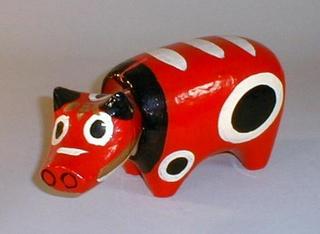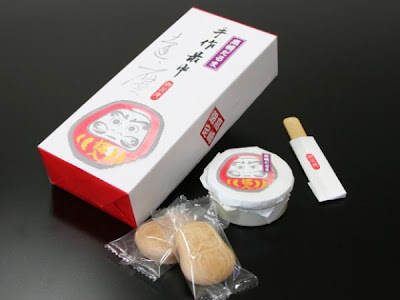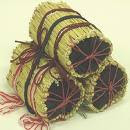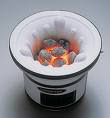[ . BACK to DARUMA MUSEUM TOP . ]
. Shizuoka Folk Art - 静岡県 .
. Legends about Kokuzo Bosatsu .
:::::::::::::::::::::::::::::::::::::::::::::::::::::::::::::::::::::::::::::::::::::::::::::::::::::
Hamamatsu Daruma Market 浜松だるま市
Kokuuzoo, Kokūzō and Daruma Market
浜松市の虚空蔵尊とだるま市
At the temple
Kokuzo-Ji 虚空蔵寺 (Kokuuzooji)
宝的山蔵興寺
 © PHOTO : guppy.cocolog-wbs.com/nikond300
© PHOTO : guppy.cocolog-wbs.com/nikond300

 A big Daruma
A big Daruma
:::::::::::::::::::::::::::::::::::::::::::::::::::::::::::::::::::::::::::::::::::::::::::::::::::::
Kokuzo Bosatsu 虚空蔵菩薩 Kokūzō
Akashagarbha Bodhisattva
 Bodhisattva of Wisdom and Memory
Bodhisattva of Wisdom and Memory
Kokūzō is especially important to Japan’s Shingon sect of Esoteric Buddhism (Mikkyō 密教). Kokūzō symbolizes the "vast and boundless" Buddha wisdom that permeates the universe. Believers pray to Kokūzō to grant them wisdom on their quest toward enlightenment. In Japan, people also pray to Kokūzō to improve their memory, technical skills, and artistic talents.
Gumonjihō 求聞持法
Esoteric Rite to Improve One’s Memory
Morning Star Mantra, Kokūzō as the Morning Star
Five Great Kokūzō
Read more HERE
- Buddhist Deities - Mark Schumacher -
. Kokuuzoo Doo 虚空蔵堂 temple hall .
in Muramatsu, Ibaraki 村松
.................................................................................
Kokuuzoo Jinja 虚空蔵神社 shrine Kokuzo Jinja
Tono, Iwate
岩手県遠野市宮守町達曽部
Miyamoricho Tatsusobe, Tono
The date of its foundation is not clear. At the beginning of the steps leading up to the shrine is a stone memorial for mount Gassan 月山の石塔, near the torii gate are more monuments reminding of The Three Mountains of Dewa 出羽三山.
Maybe there was an influence of Tendai or Shingon Buddhism.
There is a saying in the Tendai scriptures, where the celestial elements of Sun, Moon and Stars are mentioned as the beginning and end of our life and wisdom.
生の始まりを知ろうと欲するなら日月星を知るべし。
生の終わりを知ろうと欲するなら日月星を仰ぐべし。
Fugen in this shrine is maybe seen as the deity of the star
Kinsei 金星
Venus
At the back of this shrine is mount Dogusoku Yama 胴具足山 (615 m).
Legends of the Abe clan 安倍一族 are many in this region. This clan also revered a shrine dedicated to the stars
星ノ宮神社 Hoshi no Miya Jinja .

 source : dostoev.exblog.jp - 遠野の不思議
. Tono Jisha Meguri 遠野寺社巡り
source : dostoev.exblog.jp - 遠野の不思議
. Tono Jisha Meguri 遠野寺社巡り
temples and shrines in Tono, Iwate .
and
Abe no Sadato 安倍貞任 (1019 – 1062)
- - - - -
There is one more 虚空蔵神社 in Akita, Yuzawa Hot Spring
秋田県アキタケン湯沢市ユザワシ皆瀬ミナセ畑等字上中ノ台71
- Deities in residence
Shin-Oo no Mikoto 神王尊 シンノウノミコト
Kamurogi no Mikoto 神漏岐尊 カムロギノミコト
Kamuromi no Mikoto 神漏美尊 カムロミノミコト
- quote
Kamurogi, Kamuromi
Terms referring generically to male and female ancestral kami (sojin).
Examples can be found in the Shoku Nihongi, Engishiki, norito, Nakatominoyogoto, Hitachinokuni fudoki, Izumonokuni fudoki, Shoku Nihonkōki, and Kogoshūi. Commentators are agreed that the truncated kam means kami, while gi and mi refer, respectively, to male and female, but opinion is divided regarding the significance of the element
ro.
Kamo no Mabuchi interpreted kamuro to mean divine king, with the result that he understood the terms as referring to emperor and empress. Motoori Norinaga added the concept of ancestral deity to Mabuchi's interpretation, claiming that the two referred to divine ancestral deities of the emperor and empress. In the most general sense, the deities can be understood as ancestral kami. When the two deities are mentioned individually, they refer respectively to male and female kami, and when mentioned jointly as a pair, they refer to ancestral kami as a whole.
Various suggestions have been made regarding to which specific kami these names might have originally referred. The Kogoshūi claims that the two refer to the kami of begetting, Takamimusuhi and Kamimusuhi, but Kamo no Mabuchi argues that the reference is broader, extending to all imperial ancestral kami. In contrast, Motoori understands the terms to refer to Takamimusuhi and Amaterasu. At present, the terms are believed to refer not to any specific kami, but to different beings in accordance with the context of the historical materials in which the terms are found.
- source : Endō Jun, Kokugakuin 2005
.................................................................................
Kokuzo is the last of these 13 deities:
. Jusanbutsu, Juusanbutsu 十三仏
13 Protector Buddhas
Annual Temple Visit for Children
(juusanmairi 十三参り)
. Nine Stars Crest ... 九曜紋 ... Kuyoo Mon
4 Friday, Kokuuzoo Bosatsu
kinyoosei 金曜星(きんようせい、虚空蔵菩薩)(四緑木星)
:::::::::::::::::::::::::::::::::::::::::::::::::::::::::::::::::::::::::::::::::::::::::::::::::::
kigo for the New Year
. Hatsu Kokuuzoo 初虚空蔵 (はつこくうぞう)
First Kokuzo Ceremony
. . . CLICK here for Photos !
:::::::::::::::::::::::::::::::::::::::::::::::::::::::::::::::::::::::::::::::::::::::::::::::::::::

Aka-beko, akabeko 赤べこ the red cow
Akabeko is a famous cow amulet in the Aizu region of Japan.
Aka means "red" and beko is Aizu dialect for "cow."

The akabeko papier-mache cow is a popular souvenir from Fukushima Prefecture. According to local folklore, in the year 807 A.D., cows were used to haul materials to construct Enzoji 圓蔵寺(えんぞうじ Enzooji) temple in Yanaizu 柳津. The priest Tokuichi Daishi had started the building in 807. Since it is located high above the river, many cows had to be used to haul the boulders up to the site.
(Other legends tell of priest Gyoki as its founder, in 726. Gyoki carved the statue of Kokuzo to pray for peace and prosperity in the land. The side statues of Daikokuten and Bishamonten are said to be made by Kukai.)
When the temple was completed, one particular red cow refused to leave the site. Legend has it that the cow even turned to stone after having given its soul to the Buddha. The townspeople, duly impressed with the cow's loyalty and no doubt its ability to turn itself to stone, made small effigies of the cow, painted them red, and gave them to children as toys. Years later, when a bout of smallpox swept the country, the children who had these akabeko toys didn't get smallpox.
Enjoji holds one of the three famous statues of Kokuzo Bosatsu.
福満虚空蔵尊 Fukuman Kokuzon
Said to have been carved by Kobo Daishi himself.
After he finished the statue, he trew some wood chips in the river Tadami as offerings. Whow and behold, they turned into the delicious dace fish, nurrishing the people.
. Cows and Legends
. . . CLICK here for Photos !
Read more :
. Engimono, little things for good luck 縁起物
The Kokuzo statue is one of the three famous statues in Japan.
Fukuman Kokuzoson at Enzoji in Yanaizu-machi, Fukushima Prefecture
霊巌山圓蔵寺(福満虚空蔵尊)
Yanaizu Fukuchiman Kokuzoson, Tsuyama-cho Yanaizu, Tome City, Miyagi Prefecture
柳津山宝性院(柳津福智満虚空蔵尊)
Shokoan Temple in Yanai City, Yamaguchi Prefecture
or
Hidakaji temple, Daiman Kokuzon
村松山日高寺(大満虚空蔵尊)Ibaragi prefecture
Kiyomizu temple, Noman Kokuzon
千光山清澄寺(能満虚空蔵尊)Chiba prefecture
:::::::::::::::::::::::::::::::::::::::::::::::::::::::::::::::::::::::::::::::::::::::::::::::::::::
:::::::::::::::::::::::::::::::::::::::::::::::::::::::::::::::::::::::::::::::::::::::::::::::::::::
Kokuuzoo (Aakaashagarbha)
"Mutterschoß des leeren Raums".
Seine Weisheit und Tugend ist so grenzenlos wie der Weltraum. Verkörpert Einheit von Weisheit und Barmherzigkeit.
Entstand aus der Anbetung des Himmels.
Verkörpert die Theorie: Unendliches Glück und unendliche Weisheit sind in der Großen Leere das Gleiche.
In Japan seit dem 8. Jhd. bekannt. Erste Figuren in der Tempyoo-Zeit; als Paar mit Kannon Bosatsu beim Bau des Großen Buddhas im Tempel Toodaiji in Nara. Als Paar mit Jizoo Bosatsu ebenfalls in dieser Zeit häufig gefertigt. Dabei war Jizoo für die Hölle und Kokuuzoo für das Paradies zuständig.
KOKUU bedeutet "unübertroffen" und ZOO bedeutet "alle Schätze austeilen für die bedürftigen Menschen". Er verfügt über alle Schätze und sein Schatzhaus (zoo) ist das ganze All (kokuu). Im esoterischen Buddhismus auch als "Diamant-Schatzhaus" (Kongoozoo) oder "Diamant-Schatz" (Kongoohoo) bezeichnet.
Außerdem Spender besonderer Gedächtniskräfte. Bei dem Ritual zur Verbesserung der Gedächtniskräfte des eso~terischen Buddhismus "Gumonji-hoo" ist Kokuuzoo selbst der Hauptkultgegenstand. Die an ihn glaubenden Priester stellten bald viele Statuen und Bilder von ihm her. Dieses Ritual wurde von Kooboo Daishi besonders gepflegt.
(Im Japanischen heißt "auswendig" lernen: "aus dem Himmel lernen" (sora de oboeru).
Nummer 13 der
13 Buddhas der Totenrituale.
Seit der Edo-Zeit wurden Kinder beim 13. Geburtstag zu Tempeln des Kokuuzoo Bosatsu geführt (juusan mairi). Eigentlich sollte jedes Jahr einer der 13 Buddhas angebetet werden, dadurch verdienten die Tempel in der Edo-Zeit. Aber das wurde den Leuten in der Meiji-Zeit zu viel, so daß nur noch der zusammenfassende Tempelgang am 13. Geburtstag übrigblieb.
. Juusanbutsu 十三仏
Ikonografie:
Recht unterschiedliche Formen. Manchmal mit weiblichen Zügen.
Hohe Krone mit fünf Weisheitsbuddhas. In der rechten Hand das Schwert der Lehre, in der linken eine Lotusblüte; manchmal auch eine Sutrarolle oder das wunscherfüllende Juwel.
Sitzende Statuen im halben Lotussitz (Nara-Zeit) oder mit einem Bein über den Sockel hängend (ab Heian-Zeit).
Besondere Statuen:
 Fünf Kokuuzoo Bosatsu (Godai Kokuuzoo Bosatsu)
Fünf Kokuuzoo Bosatsu (Godai Kokuuzoo Bosatsu)
Entsprechend den fünf Weisheitsbuddhas. 五大虚空蔵
Zur weiten Verbreitung von Tugenden und Hilfen in alle Himmels~richtungen. Vertreibung von Feinden und sichere Geburt.
Seit der Heian-Zeit besonders in der Shingon-Sekte verehrt.
Fünf Bosatsu-Statuen auf fünf Tieren sitzend oder auf einem Lotussockel.
Tiere: in der Mitte: Löwe, im Osten: Elefant, im Süden: Pferd, im Westen: Pfau und im Norden: Garuda-Vogel.
Donnerkeil mit einem oder drei Zacken an einer langen Stange in der linken Hand. Hohe Krone mit den fünf Weisheitsbuddhas.
Mitte: Weiß - Hokkai - Gedatsu - Chie Kokuuzoo
Osten: Gelb - Kongô - Fukutoku - Aikyoo - Fukuchi Kokuuzoo
Süden: Grün - Hôkô - Nôman - Kani Kokuuzoo
West: Rot - Renge - Segan - Nooman Kokuuzoo
Nord: Schwarz - Gôyû (Gôyô) - Muku - Fukutoku Kokuuzoo.
.Buddhastatuen ... Who is Who
Ein Wegweiser zur Ikonografie
von japanischen Buddhastatuen
Gabi Greve, 1994
:::::::::::::::::::::::::::::::::::::::::::::::::::::::::::::::::::::::::::::::::::::::::::::::::::
Hamamatsu hariko 浜松張り子 papermachee dolls
Hamamatsu (lit. Pine Tree on the Beach") is a town in western Shizuoka.
They were quite popular since the early Meiji period and many humorous figures were included, like the monkey on a persimmon.
During WW II, most of the wooden forms were lost, but they were re-made soon to continue this special tradition of papermachee dolls.
 Futabashi San Workshop
Futabashi San Workshop 二橋さん

tora hariko 虎張り子 papermachee tiger
 Hamamatsu hariko 浜松張り子 papermachee dolls
CLICK for more photos !
. Shizuoka Folk Art - 静岡県 .
Hamamatsu hariko 浜松張り子 papermachee dolls
CLICK for more photos !
. Shizuoka Folk Art - 静岡県 .
#hamamatsudolls #kokuzo #kokuzobosatsu
:::::::::::::::::::::::::::::::::::::::::::::::::::::::::::::::::::::::::::::::::::::::::::::::::::
Daruma Ichi Markets to Sell Daruma / 達磨市
. Legends about Kokuzo Bosatsu .
[ . BACK to DARUMA MUSEUM TOP . ]
[ . BACK to WORLDKIGO . TOP . ]
:::::::::::::::::::::::::::::::::::::::::::::::::::::::::::::::::::::::::::::::::::::::::::::::::::::::::::::::::::::::::::






























































